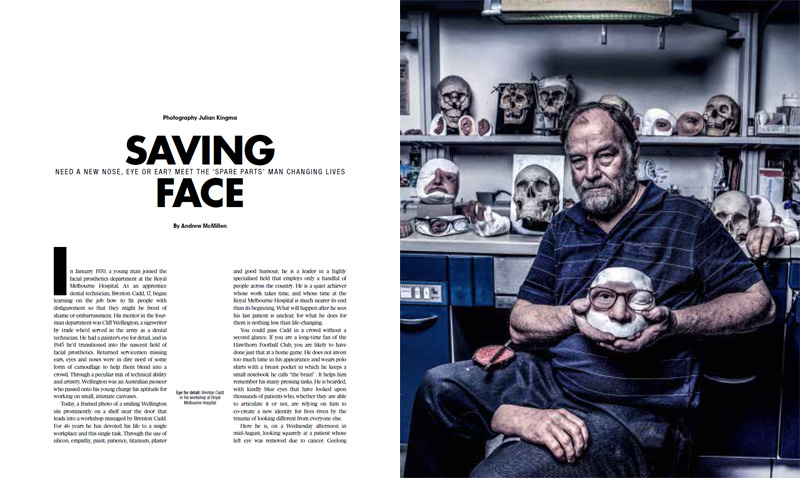The Weekend Australian Magazine story: ‘Saving Face: Brenton Cadd’, October 2016
A feature story for The Weekend Australian Magazine, published in the October 22-23 issue. Excerpt below.
Need a new nose, eye or ear? Meet the ‘spare parts’ man changing lives
In January 1970, a young man joined the facial prosthetics department at the Royal Melbourne Hospital. As an apprentice dental technician, Brenton Cadd, 17, began learning on the job how to fix people with disfigurement so that they might be freed of shame or embarrassment. His mentor in the four-man department was Cliff Wellington, a signwriter by trade who’d served in the army as a dental technician. He had a painter’s eye for detail, and in 1945 he’d transitioned into the nascent field of facial prosthetics. Returned servicemen missing ears, eyes and noses were in dire need of some form of camouflage to help them blend into a crowd. Through a peculiar mix of technical ability and artistry, Wellington was an Australian pioneer who passed onto his young charge his aptitude for working on small, intimate canvases.
Today, a framed photo of a smiling Wellington sits prominently on a shelf near the door that leads into a workshop managed by Brenton Cadd. For 46 years he has devoted his life to a single workplace and this single task. Through the use of silicon, empathy, paint, patience, titanium, plaster and good humour, he is a leader in a highly specialised field that employs only a handful of people across the country. He is a quiet achiever whose work takes time, and whose time at the Royal Melbourne Hospital is much nearer its end than its beginning. What will happen after he sees his last patient is unclear, for what he does for them is nothing less than life-changing.
You could pass Cadd in a crowd without a second glance. If you are a long-time fan of the Hawthorn Football Club, you are likely to have done just that at a home game. He does not invest too much time in his appearance and wears polo shirts with a breast pocket in which he keeps a small notebook he calls “the brain” . It helps him remember his many pressing tasks. He is bearded, with kindly blue eyes that have looked upon thousands of patients who, whether they are able to articulate it or not, are relying on him to co-create a new identity for lives riven by the trauma of looking different from everyone else.
Here he is, on a Wednesday afternoon in mid-August, looking squarely at a patient whose left eye was removed due to cancer. Geelong retiree Pamela Flatt, 68, sits on a high-backed dentist’s chair while her husband and daughter perch nearby. Flatt’s left eye socket is now covered by a skin graft and her disguise is a pair of thick-framed spectacles, with the left eye coloured solid white. In the near future she will no longer have a use for these glasses as a transformation led by Cadd is slowly taking place. Around the edge of her eye socket, screwed into bone, are three abutments made of pure titanium. Soon, a silicon-based prosthesis will be clipped into place with magnets.
Flatt is a grandmother of six and a great-grandmother of three. Since her nine-hour operation to remove the cancer over a year ago, she has hardly locked herself away from the public eye: in fact, she has just returned from a trip to Thailand with a girlfriend, where she rode on an elephant. “Why not?” she reasons. “Life’s too short.”
Despite her positive outlook, the metal implants have drawn attention. “Kids are looking at me like I’m an alien or something: ‘That lady’s got funny things in her head!’ ” she says. “They weren’t bothered until I had those things put in.” Nerve damage means that she can’t feel the titanium plate behind her skin, nor Cadd’s hands as he uses a small torque screwdriver to tighten the abutments. He then covers her eye socket with two layers of a rubber-like material for making a cast and lets it set on her face for a couple of minutes. Just like having a wax job, she quips.
While she sits still and silent, Flatt’s daughter steps in to take a snapshot for posterity. “Someone usually takes a photo,” Cadd says, smiling. With care, he removes the cast, which will later be used for a custom-made mould that fits the exact contours of her eye socket. He excuses himself to retrieve from next door a beautifully hand-crafted eye prosthesis for a younger woman, complete with thick lashes, a realistic brown eye and dark eyeliner. It’s a work of art. “That’s what we’re aiming for,” Cadd says. “But we’re still about five visits off something like that.”
The appointment concludes after an hour, but before Flatt heads back to Geelong she turns to Cadd and jokes: “I can’t be a one-eyed Cats supporter then, can I?”
To read the full story, visit The Australian. Above photo credit: Julian Kingma.
